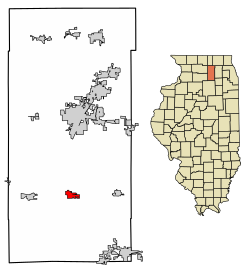Waterman, Illinois
Waterman | |
|---|---|
 Location of Waterman in DeKalb County, Illinois. | |
 Location of Illinois in the United States | |
| Coordinates: 41°46′15″N 88°46′29″W / 41.77083°N 88.77472°W | |
| Country | United States |
| State | Illinois |
| County | DeKalb |
| Area | |
| • Total | 1.45 sq mi (3.76 km2) |
| • Land | 1.45 sq mi (3.76 km2) |
| • Water | 0.00 sq mi (0.00 km2) |
| Population (2010) | |
| • Total | 1,506 |
| • Estimate (2019)[2] | 1,500 |
| • Density | 1,033.77/sq mi (399.24/km2) |
| Time zone | UTC-6 (CST) |
| • Summer (DST) | UTC-5 (CDT) |
| ZIP Code(s) | 60556 |
| Area code | 815 |
| FIPS code | 17-79163 |
| Wikimedia Commons | Waterman, Illinois |
| Website | https://villageofwaterman.com/ |
Waterman is a village in DeKalb County, Illinois, United States. The population was 1,506 at the 2010 census, up from 1224 at the 2000 census.
The village is known for the Waterman and Western train line that operates in Lion's Club Park. This 1/3 scale train line comprises a 1/2 mile train line circling the park and is a hobby of a local resident.
Geography
Waterman is located at 41°46′15″N 88°46′29″W / 41.77083°N 88.77472°W (41.770971, -88.774697).[3]
According to the 2010 census, Waterman has a total area of 1.482 square miles (3.84 km2), of which 1.48 square miles (3.83 km2) (or 99.87%) is land and 0.002 square miles (0.01 km2) (or 0.13%) is water.[4]
Demographics
| Census | Pop. | Note | %± |
|---|---|---|---|
| 1880 | 291 | — | |
| 1890 | 351 | 20.6% | |
| 1900 | 358 | 2.0% | |
| 1910 | 398 | 11.2% | |
| 1920 | 401 | 0.8% | |
| 1930 | 520 | 29.7% | |
| 1940 | 579 | 11.3% | |
| 1950 | 750 | 29.5% | |
| 1960 | 916 | 22.1% | |
| 1970 | 990 | 8.1% | |
| 1980 | 943 | −4.7% | |
| 1990 | 1,074 | 13.9% | |
| 2000 | 1,224 | 14.0% | |
| 2010 | 1,506 | 23.0% | |
| 2019 (est.) | 1,500 | [2] | −0.4% |
| U.S. Decennial Census[5] | |||
As of the census[6] of 2000, there were 1,224 people, 456 households, and 338 families residing in the village. The population density was 1,221.5 people per square mile (472.6/km2). There were 471 housing units at an average density of 470.0 per square mile (181.9/km2). The racial makeup of the village was 98.53% White, 0.25% African American, 0.08% Native American, 0.99% Asian, 0.57% from other races, and 0.49% from two or more races. Hispanic or Latino of any race were 1.31% of the population.
There were 456 households out of which 40.4% had children under the age of 18 living with them, 62.3% were married couples living together, 9.0% had a female householder with no husband present, and 25.7% were non-families. 22.8% of all households were made up of individuals and 12.9% had someone living alone who was 65 years of age or older. The average household size was 2.68 and the average family size was 3.18.
In the village, the population was spread out with 30.5% under the age of 18, 7.7% from 18 to 24, 29.4% from 25 to 44, 17.2% from 45 to 64, and 15.2% who were 65 years of age or older. The median age was 35 years. For every 100 females, there were 91.3 males. For every 100 females age 18 and over, there were 92.1 males.
The median income for a household in the village was $47,500, and the median income for a family was $52,778. Males had a median income of $41,726 versus $23,824 for females. The per capita income for the village was $18,836. About 5.6% of families and 6.2% of the population were below the poverty line, including 7.2% of those under age 18 and 5.6% of those age 65 or over.
References
- ^ "2019 U.S. Gazetteer Files". United States Census Bureau. Retrieved July 14, 2020.
- ^ a b "Population and Housing Unit Estimates". United States Census Bureau. May 24, 2020. Retrieved May 27, 2020.
- ^ "US Gazetteer files: 2010, 2000, and 1990". United States Census Bureau. 2011-02-12. Retrieved 2011-04-23.
- ^ "G001 - Geographic Identifiers - 2010 Census Summary File 1". United States Census Bureau. Archived from the original on 2020-02-13. Retrieved 2015-12-25.
- ^ "Census of Population and Housing". Census.gov. Retrieved June 4, 2015.
- ^ "U.S. Census website". United States Census Bureau. Retrieved 2008-01-31.

